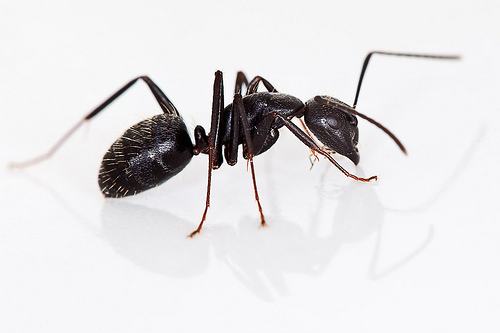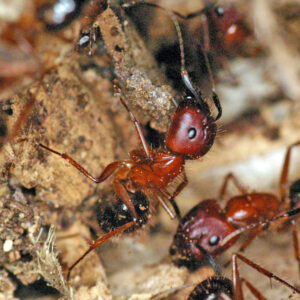The life cycle of a carpenter ant.
Carpenter ants build nests inside wood. They construct galleries where the wood has been chewed out. Unlike termites, carpenter ants don’t eat wood. They remove it to make their colonies. Commonly carpenter ants are identifiable by the small piles of shavings found outside their nests. Carpenter ants prefer dead or damp wood, so places like decks are favourite hiding spots for them. They are are a nuisance to homeowners because carpenter ants can cause significant structural damage to wooden buildings.
The life of a carpenter ant begins with the nuptial flight.
Occurring in late spring or early summer, the carpenter ant’s nuptial flight is dependent on the seasonal weather. They will take a mating flight. Male carpenter ants, or swarmer, mate with winged females. After mating, females shed their wings and males die.
After, the female ants search for a new site to build their colonies. The queen will often seek small cracks in wooden structures. She will enter this space and lay her first batch of eggs. The queen stays in her chamber until the first batch of eggs becomes adult workers. Fat revers and wing muscles provide the queen with nourishment. Food is given to the young by the queen’s salivary glands up until the workers are capable of foraging. The queen will be the main caregiver for the first brood of carpenter ants. After that the initial brood will look after the growth of new generations.
A larger and stable colony takes about 3 to 6 years to develop.
A carpenter ant will live between 6 to 12 weeks from egg to adult. Cold weather can contribute to making the development time longer. It can add about 10 months. Queens only have one role. To lay eggs. As soon as workers mature they take on responsibilities of the colony. They will forage for food, tend to eggs, larvae and pupae, and excavate galleries to grow the nest. There are two types of workers. Major workers act as soldiers and protect the colony. Minor workers forage for food and take care of the young.
After about two years the queen starts to produce males and females who begin to leave and start other colonies. Usually in a carpenter ant colony there i only one queen. Once the males and females leave their first colonies the process begins over again.
Signs of a carpenter ant infestation.
- Damage to woods that are damp, old or decaying. So, your inner walls and structure work in your home are prime targets.
- Finding small piles of wood shavings around large carpenter ant colonies. Finding ‘frass’ is a major indicator of larger infestations.
- Carpenter ants make a creeking or tapping noise in wood. Listen for these sounds.
- Spotting carpenter ants. Winged ants means there are major problems.
- Carpenter ants are nocturnal. Spotting them by flashlight.
- Carpenter ants travel far to forage. You might have to follow them quite fa to find the nest.
Carpenter ant prevention.
The best way to stop carpenter ants is by sealing entry points into your home. Don’t give them access to your wooden structures. Walk around the outside of your home and make sure all windows and doors are properly sealed. Ants can easily enter through tiny holes in the outer walls of your home. Stop the problem before it even begins.
Merrickville carpenter ant removal.
There are many different species of ants. Determining the type of ant can be difficult. If you find an evidence of carpenter ants, make sure to contact Truly Nolen Pest Control.

